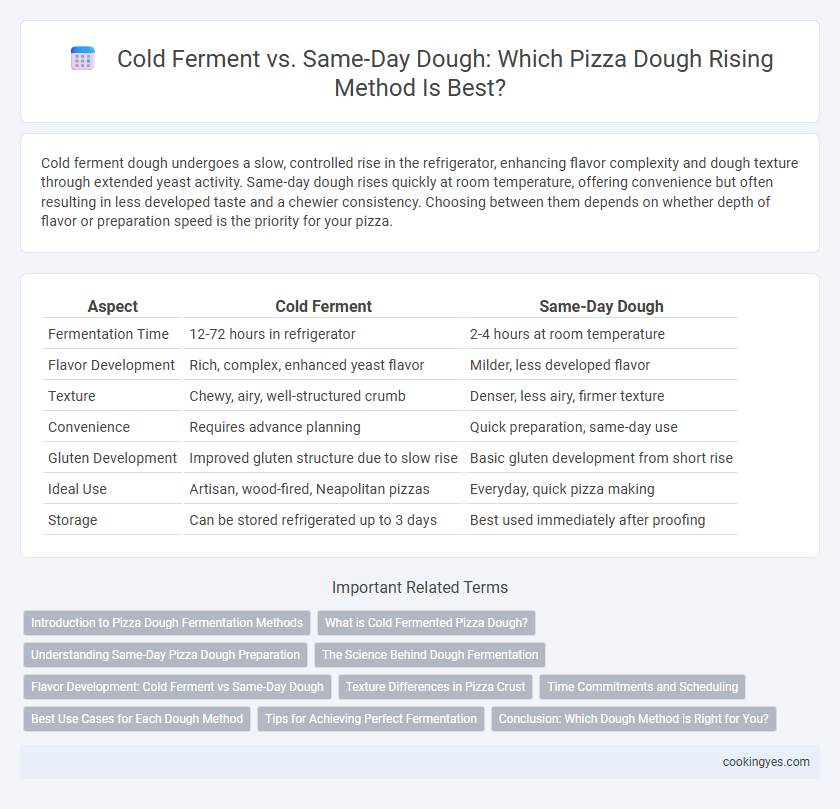Cold ferment dough undergoes a slow, controlled rise in the refrigerator, enhancing flavor complexity and dough texture through extended yeast activity. Same-day dough rises quickly at room temperature, offering convenience but often resulting in less developed taste and a chewier consistency. Choosing between them depends on whether depth of flavor or preparation speed is the priority for your pizza.
Table of Comparison
| Aspect | Cold Ferment | Same-Day Dough |
|---|---|---|
| Fermentation Time | 12-72 hours in refrigerator | 2-4 hours at room temperature |
| Flavor Development | Rich, complex, enhanced yeast flavor | Milder, less developed flavor |
| Texture | Chewy, airy, well-structured crumb | Denser, less airy, firmer texture |
| Convenience | Requires advance planning | Quick preparation, same-day use |
| Gluten Development | Improved gluten structure due to slow rise | Basic gluten development from short rise |
| Ideal Use | Artisan, wood-fired, Neapolitan pizzas | Everyday, quick pizza making |
| Storage | Can be stored refrigerated up to 3 days | Best used immediately after proofing |
Introduction to Pizza Dough Fermentation Methods
Cold ferment pizza dough undergoes a slow fermentation process in the refrigerator, typically lasting 24 to 72 hours, enhancing flavor complexity and improving dough texture. Same-day dough fermentation is a quicker process, usually completed within a few hours at room temperature, resulting in a softer crust but less developed flavor. Understanding these fermentation methods helps pizza makers balance time constraints with desired dough characteristics for optimal crust quality.
What is Cold Fermented Pizza Dough?
Cold fermented pizza dough undergoes a slow fermentation process in the refrigerator, typically lasting 24 to 72 hours, which enhances flavor development and improves dough structure. This method allows natural yeast and bacteria to break down starches and proteins, resulting in a more complex, tangy taste and a chewier texture compared to same-day dough. Cold fermentation also increases dough extensibility, making it easier to stretch and achieve an airy, crisp crust.
Understanding Same-Day Pizza Dough Preparation
Same-day pizza dough preparation involves mixing ingredients and allowing the dough to rise within a few hours, typically 2 to 4 hours, resulting in faster fermentation and a dough that is easier to handle. This method produces a softer texture and a milder flavor compared to cold ferment, since the yeast has less time to develop complex flavor compounds. Same-day dough is ideal for quick pizza making, maintaining elasticity and hydration while sacrificing some depth in taste achieved through longer fermentation periods.
The Science Behind Dough Fermentation
Cold fermentation allows yeast to slowly metabolize sugars at low temperatures, producing more complex flavors and a chewier texture due to extended enzyme activity and gluten development. Same-day dough undergoes rapid fermentation at room temperature, leading to quicker rise times but less flavor depth and a softer crust. The controlled environment of cold ferment enhances lactic acid bacteria growth, improving dough extensibility and overall pizza crust quality.
Flavor Development: Cold Ferment vs Same-Day Dough
Cold ferment pizza dough undergoes a slow fermentation process in the refrigerator for 24 to 72 hours, allowing complex flavors to develop through extended yeast and enzymatic activity. Same-day dough, fermented at room temperature for a few hours, produces a faster rise but lacks the depth and richness of flavor achieved in cold fermentation. The prolonged cold ferment enhances dough acidity, aroma, and texture, resulting in a more flavorful and nuanced crust compared to the quicker same-day preparation.
Texture Differences in Pizza Crust
Cold ferment pizza dough undergoes a slow fermentation process in the refrigerator for 24 to 72 hours, resulting in a chewier, more complexly flavored crust with a crispier exterior and airy crumb. Same-day dough rises quickly at room temperature, producing a softer, less textured crust with a more straightforward yeast flavor and a denser crumb structure. The extended cold fermentation enhances gluten development and enzymatic activity, which significantly improves the pizza crust's texture and bite quality.
Time Commitments and Scheduling
Cold ferment dough requires 24 to 72 hours of refrigeration, allowing slow yeast activity that develops deeper flavor and improved texture with minimal active time but longer overall waiting periods. Same-day dough rises in 1 to 3 hours at room temperature, offering quicker turnaround for immediate pizza making but often sacrificing complexity in taste and chewiness. Choosing between these methods depends on your time commitments and scheduling flexibility, prioritizing flavor depth versus immediate convenience.
Best Use Cases for Each Dough Method
Cold ferment dough is ideal for achieving complex flavor development and a chewier texture, making it perfect for artisanal pizzas or those requiring extended preparation time. Same-day dough is best suited for quick turnaround orders, providing a softer crust and faster rise, ideal for casual dining or high-volume pizzerias. Each method enhances specific pizza styles depending on time constraints and desired crust characteristics.
Tips for Achieving Perfect Fermentation
Cold ferment dough requires a slow, controlled rise in the refrigerator for 24 to 72 hours to develop complex flavors and improve texture. Same-day dough, rising at room temperature for 1 to 3 hours, demands careful monitoring to prevent overproofing and ensure optimal gluten development. To achieve perfect fermentation, maintain consistent temperature, use quality yeast, and adjust hydration levels based on flour type and ambient conditions.
Conclusion: Which Dough Method is Right for You?
Cold ferment dough develops complex flavors and improved texture due to extended yeast activity, making it ideal for artisanal pizzas with a chewy crust. Same-day dough offers convenience and quicker preparation, suitable for casual cooking or when time is limited. Choosing between cold ferment and same-day dough depends on your schedule, desired flavor depth, and texture preferences.
Cold ferment vs Same-day dough for pizza rising Infographic

 cookingyes.com
cookingyes.com